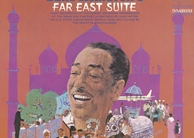The Origins of Cuban Music and its Cultural and Spiritual Importance Within the Cuban Diaspora Community
By
2015, Vol. 7 No. 10 | pg. 2/2 | « New Avenues for Son to Be HeardSon was “recorded and promoted by large American corporations such as RCA Victor.” The United States established an omnipresent presence on the island between the late 19th century and the turn of the 20th century. Interestingly enough, the Americans elite accepted the son and they had the political and economic influence to make this maligned form of music go global. And it did. The Cuban elites were nowhere near as receptive as the Americans. In fact, they were hostile to the notion that Afro-Cuban music would define the Cuban identity. The aristocracy could only accept these Afro-Latin rhythms as a benign influence in Cuban dance and song rather than a symbol of nation. Had Cuba’s ruling class accepted the son in its inception, they would have had to accept its collective African heritage and propagate that abroad (Chambers 503). Although music formed an avenue for transculturation in Cuba, the cultural transition was not smooth by any means. The background behind the sensual and exciting son perpetuated the frictions “between Cuban elites and the masses to define lo cubano” or what is Cuban. The elites looked to Europe and the United States “for representations of culture and modernity;” while the black and mulatto communities assembled a musical genre that became an icon of Cuban culture and identity (Chambers 497).The Emergence of a New American MusicSalsa emerged in New York City in the early 1960s, when a group of disenfranchised Cuban musicians arrived in the United States fleeing the censorship of the new communist regime in their country. These Cuban maestros also collaborated with some of the greatest jazz musicians of the times, such as Dizzy Gillespie (García 195). From those sessions Latin jazz was born and became a new genre. This called the attention of Puerto Rican band leaders such as Willy Colón, Tito Puente and other musicians. At the time, the most popular Puerto Rican sounds heard were plena, bomba, and boleros. The name “salsa” was coined by Tito Puente, who appeared on TV commercials regularly advertising Goya Food products, such as “salsa de tomate” or tomato sauce. This product was one of Goya’s most popular products on the Hispanic market in those days, due in part to Tito Puente’s popularity and charisma. “Salsa” became a catchphrase that Puente used during his guest appearances to describe the essence of the new music that had emerged from his collaboration with the Cubans. That was the birth of salsa as the United States, and the rest of the world, as it is known today. “Salsa” gave voice to the Hispanic community during the post-industrial era of the late 1960’s through 1970’s when employment opportunities became scarce, neighborhoods and families disintegrated as a result (Díaz; Singer and Martínez 177-179). The arrival of the son gave composers the freedom to innovate and improvise with Afro-Cuban lyrics. This genre of music is best viewed as part of the bedrock of “traditional musical forms of the Spanish speaking Caribbean.” It highlights the best integration of the religions the Afro-Hispanic community incorporated (African religion and Catholicism), which defined the culture in that region (Gutiérrez 297-298). Son de la Loma by Trío Matamoros depicts a conversation between a child and mother. Lomas are hills; however, the song carries a multidimensional meaning because African spirits live in the hills of the wilderness. The woods are the designated place for the spirits and dead. The final interpretation can be derived that the “singers live with those sacred spirits” and that is the place where they derive their special talents (Gutiérrez 298).
The Post-Industrial Effect on Music in Cuba and the United StatesAs the son morphed into salsa, post-Revolution Cuba was the breeding ground for timba, a blend of Ibero-American and Iberian musical styles such as the Spanish flamenco. Timba was created by and for black people in Cuba. It shined a light on Afro-Cuban heritage and pride as a lifeline to Cuban identity, “machismo and sexuality.” On the flipside, timba depicts “Cuban mulatto women as gold diggers, whores and race traitors.” This is not unlike some of the misogynistic themes found in hip-hop music (Hernández-Reguant 32, 35). Curiously enough, both timba and hip-hop became popular in the 1980’s and served as a voice for sullen and disenfranchised young men. During this decade, the United States was gripped by a crack and cocaine epidemic as well as a job base that was outsourced abroad, and an administration that displayed a nonchalant and casually judgmental attitude with respects to the disadvantaged. Cuba also suffered greatly in 1980’s from the effects of the dissolution of the Soviet Union as the island’s embargo and socialist government’s policies nearly strangled its economy and people. This was the catalyst for the Special Period in Time of Peace era of the 1990’s where the government instituted strict rations on the consumption of fuel, food and resources (Hernández-Reguant 31). It was not a surprise that some beautiful women on the island left with and sometimes married white Europeans as a way to improve their dire circumstances. As a result, Afro-Cuban men felt abandoned and cast out. The true nature of said problems lies in broken economic policies and politicking rather than loose and materialistic women. Although men in both countries may have been aware of the scope of their tribulations, women became “a scapegoat as she is the last thing that he can try to control and identify a common heritage with.” It is also important to note that women play no significant role in timba. Despite the strides that feminism made in Cuba and the U.S., women were still the weakest link and became a popular target in arts and entertainment (Hernández-Reguant). Although the United States and Cuba had certain post-industrial similarities in their society, there are key differences between the lives of blacks in both countries. Cuba instituted a requirement to provide free access to vocational programs, medical treatment, sports and the arts that benefitted the community and reduce social endangerment. These measures were successfully carried out despite their budget shortfalls. On the other hand, post-industrial (i.e. late 1970’s and beyond) United States began to see sharp contrasts between well-to-do African-Americans climbing a corporate ladder that became available for them to climb post-Civil Rights Era, and their socioeconomically disadvantaged counterparts (Díaz). Timba was the Cuban man’s response to post-feminist society. The same could be argued for American hip-hop. I want to clarify that chauvinism is nothing new in Cuban or American music. However, in pre-Revolution Cuba and pre-sexual revolution America it was cloaked in veiled romanticism sometimes mixed with perilous passions in the name of love for a woman. Now that women have more sociopolitical mobility, some men took the regressive route to respond to the perception of loss of authority in their lives and that of women (Hernández-Reguant 33, 35). Beyond Latin America and the United StatesThese collaborations went beyond the Spanish speaking world. Afro-Cuban music became Senegal’s song during the Independence period of the 1960’s when that generation assumed power. Embracing Latin music embodied a zeitgeist tropical attitude not unlike the feelings that the balmy beaches of West Africa can elicit. This newly created set of acceptable norms by the Senegalese formed a solid base for a sustainable post-colonial society. Preserving Afro-Cuban music in Senegal maintained and solidified these traditions; thus allowing the newly liberated nation to act as free agents political life. Viewing and participating in the Afro-Cuban performance created a safe space “where generational rivalries and differing notions of cosmopolitanism” are acted out and mediated in a controlled environment (Shain 187-188). Culture is one of the only means that marginalized groups found to be included into the mainstream in post-colonial societies such as Cuba and the United States. They created their own capital and culture is its biggest and most valuable export. One would hope that the creators of these valuable works would become financially wealthy. Instead, people of European descent appropriate African-derived cultural such as dance, music, food, and religious practices. (Chambers 497). In ClosingThe African diaspora arose from “several centuries of institutionalized slavery.” That was the motor for “cultural, racial and ethnic” exchanges and mixtures which still serve as a blueprint in the arts today. “African languages make up an intrinsic part of many Cuban music genres.” For five centuries, Cuban music is the end result of the unique meetings that emerged from diverse cultures “that reached the island in one way or another” (Gutiérrez 295-296; Hodges; Leymarie). The orishas have mutable qualities and have no boundaries because they are spirits (Concha-Holmes 490). For devotees of Santería and other African based religions, these gods are eternal. Yemayá can be found in Lagos, Nigeria as much as Miami or Madrid. She is wherever you invoke her (Gleason). Spirituality is like water, one sees it but may not know or understand the molecules contained in it. Achieving and maintain that purity lies in the practitioner and the forces one chooses to blend with. If the person neglects their water, it will dissipate into the atmosphere. Once that happens, the person loses an intrinsic part of their history. Afro-Cuban musical history can teach musicians and vocalists irrespective of genre and language that there is so much more to this craft than meets the naked eye. One becomes an interpreter and bridge to another world, both past and present. Devotion and sacrifice is required of the artist in order to receive a gift that can be shared with others. It is important that musicians distance themselves from the notion of grooming themselves for a fickle marketplace in order to have lasting impact and success. ReferencesBenítez-Rojo, Antonio. “The Role of Music in the Emergence of Afro-Cuban Culture.” Research in African Literatures 29.1 (1998): 179-184. JSTOR. Indiana University Press. Web. http://www.jstor.org/stable/3820540?seq=1#page_scan_tab_contents. Boadle, Anthony. “Yoruba Gods Protect Fidel Castro: Priest.” Ed. Eric Beech. Reuters. Thomson Reuters, 21 Jan. 2008. Web. 11 Aug. 2015. http://www.reuters.com/article/2008/01/21/us-cuba-castro-priest-idUSN2141852320080121 Chambers, Glenn A. “The Rise and Son the Legitimization of African-Derived Culture in Cuba, 1908-1940.” Callaloo 30.2 (2007): 497-507. Web. http://www.jstor.org/stable/30129758. Concha-Holmes, Amanda D. “Cuban Cabildos, Cultural Politics, and Cultivating a Transnational Yoruba Citizenry. Cultural Anthropology 28.3 (2013): 490-503. Print. Díaz, Julia. “Interview about Cuban Religion, Music and Culture.” Personal interview. 13-20 July 2015. Julia Díaz is my mother. García, David. “We Both Speak African”: A Dialogic Study of Afro-Cuban Jazz. Journal of the Society for American Music 5. (2011): 195-233. Web. http://journals.cambridge.org/abstract_S1752196311000034. Gleason, Judith. “Notes on Two Sacred Afro-Cuban Songs in Contemporary Settings.” Research in African Literatures 24.3 (1993): 113-121. JSTOR. Indiana University Press. Web. http://www.jstor.org/stable/3820119?seq=1#page_scan_tab_contents. González, Servando. The Secret Fidel Castro: Deconstructing the Symbol. Oakland, CA: Spooks, 2001. Print Gutiérrez, Mariela A. “Afro-Cuban Lyrics and Thematics in the ‘Canción Cubana’ as Musical Genre.” Hispanic Research Journal 14.4 (2013): 295-312. Web. Harvey, Tom. “Castro Regime Lets Santeria Thrive in Cuba.” Sun-Sentinel [Fort Lauderdale, FL] 22 Oct. 1992: n. pag. SunSentinel. Tribune Publishing. Web. 11 Aug. 2015. http://articles.sun-sentinel.com/1992-10-22/news/9202240953_1_santeria-altar-religion Hernández-Reguant, Ariana. “Havana’s Timba.” Transformations in the Cultural Production of Blackness Globalization and Race (2012): 249-278. Web. Hodges, Norman E. W. Black History. New York: Monarch, 1971. Print. Mancuso, Steve. “Afro-Cuban Batá Rhythms Adapted to Drumkit.” Canadian Musician n.d.: 28-29. Web. http://www.canadianmusician.com. Safa, Helen I. “Commentary on Race and Revolution in Cuba.” Souls 1.2 (1999): 86-92. Web. Shain, Richard M. “The Re(Public) of Salsa: Afro-Cuban Music in Fin-de-Siècle Dakar.” Africa 79.02 (2009): 186-206. Web. Sigler, Bret. “God, Babalawos and Castro.” God, Babalawos and Castro. University of California Berkeley, 5 Apr. 2002. Web. 11 Aug. 2015. http://journalism.berkeley.edu/projects/cubans2001/story-religion.html Singer, Roberta L. and Elena Martínez. “A South Bronx Latin Music Tale.” CENTRO Journal 16.1 (2004): 176-201. Print. Stewart, Jack. “Cuban Influences on New Orleans Music.” Editorial. Arhoolie Records 1999: 1-14. Arhoolie Records. Arhoolie Productions. Web. http://www.arhoolie.com. The Purdue OWL. Purdue U Writing Lab, 2010. Web. Suggested Reading from Inquiries Journal
Inquiries Journal provides undergraduate and graduate students around the world a platform for the wide dissemination of academic work over a range of core disciplines. Representing the work of students from hundreds of institutions around the globe, Inquiries Journal's large database of academic articles is completely free. Learn more | Blog | Submit Latest in Music |


















